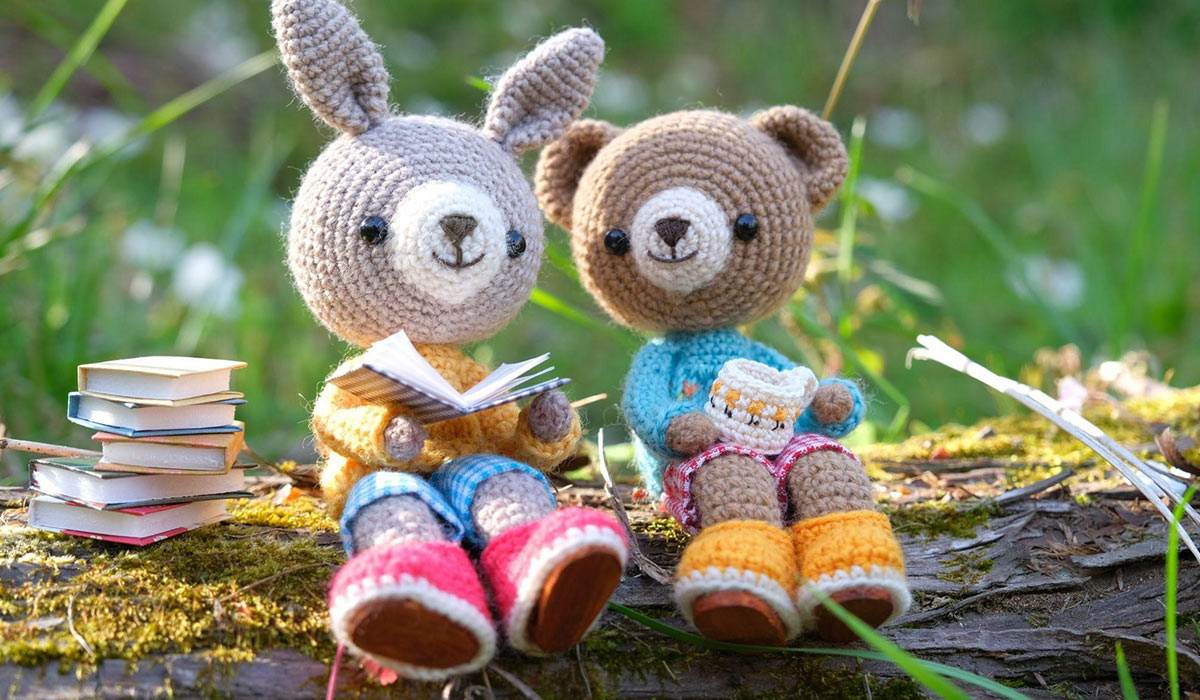
Amigurumi is the beautiful art of making toys with your regular crochet hooks. Originating in Japan, the crochet craft went on to take over the hearts of crocheters worldwide. Amigurumi crochet is a delightful and popular craft that involves creating adorable stuffed toys and characters using a combination of simple crochet stitches. Whether you're new to crochet or an experienced crafter, diving into the amigurumi world can be a rewarding and fun experience.
Here's a beginner's guide to help you get started on your amigurumi journey.
1. Gather Your Supplies
To begin your amigurumi adventure, you'll need a few basic supplies. You can work with your regular crochet hooks and any matching yarn weight.
Pattern: Creating animals, cartoons, unique shapes, and toys requires a design. The step-by-step instructions help you create the project as the pattern designer intends.
Yarn: Choose yarn in your preferred colors. Worsted weight or DK (double knit) yarn is commonly used for amigurumi. The dyes, weight, and fibers depend on the pattern. It is always recommended not to work with delicate yarns as the filling of the toy might spill over.
Crochet Hooks: Select a crochet hook size appropriate for your chosen yarn. A smaller hook size than recommended on the yarn label can help create tight stitches and prevent stuffing from showing through. If you have a crochet hook set, you will have multiple sizes. The recommended dimensions are 3.25 mm to 4mm.
Fiberfill or Stuffing: This will fill your amigurumi creations and give them their shape.
Yarn Needle: For sewing openings, attaching parts, and weaving in loose ends.
Safety Eyes or Embroidery Thread: These are used to create the eyes of your amigurumi. Safety eyes are easy to attach, while embroidery thread can be employed to craft eyes for a different look.
Stitch Markers: Helpful for keeping track of rounds and stitches.

2. Learn the Basic Stitches and Techniques
Before you dive into amigurumi, make sure you're comfortable with the basic crochet stitches: chain (ch), single crochet (sc), increase (inc), and decrease (dec). These stitches form the foundation of amigurumi and are used to create various shapes and textures in your creations.
Crochet Techniques for Amigurumi Patterns
Magic Ring:
In the amigurumi world, every project begins with a magic ring, also known as an adjustable loop. Whether you're crafting the head, body, legs, arms, or any other part, the magic ring is your starting point. This essential stitch is the foundation for each piece you create, making it a skill worth mastering.
While alternative methods exist to start an amigurumi piece, the magic ring is the superior and most aesthetically pleasing choice.
Single Crochet:
The fundamental stitch in amigurumi is the single crochet. This stitch forms the surface of your creation and serves as the basis for the simplest amigurumi toys.
In the world of amigurumi, we predominantly crochet in the round. The initial round of single crochet stitches is worked within the magic ring, but each subsequent round is built on top of the previous one.
Achieving an even and pleasing surface requires practicing the single crochet stitch extensively to attain the desired level of tension.
Increasing Stitches:
When you aim to broaden the width of your piece, you must increase the number of stitches. This involves working more stitches each successive round until your work reaches the desired width.
For instance, in the first round, we commonly start with 6 single crochet stitches. In the second round, we place 2 single crochet stitches in each stitch from the prior round, resulting in 12 stitches. This constitutes an increase of 6 stitches.
Decreasing Stitches:
Conversely, to narrow down your piece, decreasing the stitch count is necessary. This entails crocheting stitches together to reduce the number at the end of the round.
Imagine you have 18 stitches but intend to have only 12 stitches in the following round. This entails decreasing every third stitch. The process involves working a regular single crochet stitch followed by crocheting the subsequent 2 stitches together to achieve a decrease. This sequence is repeated throughout the round.
Let’s look at the two distinct methods of decreasing: the regular decrease and the invisible decrease. The latter is highly recommended in Amigurumi due to its delicate nature. As its name suggests, the imperceptible reduction allows you to decrease stitches without affecting the crocheted surface, propelling you to an advanced Amigurumi skill level.
Fasten Off:
When you approach the conclusion of an amigurumi piece, the pattern usually directs you to "Fasten off" or "Finish off." How do you execute this step effectively? In my tutorial, I'll reveal a specialized technique to employ at the end of your work. This technique ensures a tidy finish, leaving behind a lengthy yarn tail and an even edge, facilitating the seamless sewing of the pieces.
3. Choose a Simple Pattern
Start with a simple Amigurumi pattern suitable for beginners. Look for instructions that provide photos or written tutorials. Designs labeled "beginner-friendly" or "easy" will guide you effortlessly through creating your finished item.
Read the pattern thoroughly before starting. Pay attention to the abbreviations and any special stitches used. Most instructions specify the number of stitches per round and any increases or decreases required. Follow the pattern instructions closely to achieve your amigurumi's intended shape and size.
4. Keep Track of Rounds
Use stitch markers to mark the beginning of each round. This helps you keep track of your progress and ensures that your amigurumi pieces are symmetrical.
5. Stuffing and Shaping
As you work, stuff your amigurumi pieces with fiberfill to give them a three-dimensional shape. Stuff firmly but not too tightly, as overstuffing can distort the shape. Use your crochet hook or a stuffing stick to push the filling into small spaces.
6. Assemble and Finish
Once all the pieces are crocheted and stuffed, it's time to assemble your amigurumi. Use your finishing needle to sew the parts according to the pattern's instructions. Attach safety eyes or embroider the eyes using embroidery thread. Weave in any loose ends to secure your work.
7. Experiment and Have Fun
Amigurumi is all about creativity and enjoyment. Once you've mastered the basics, don't hesitate to experiment with different yarn colors, stitches, and patterns to create your unique characters.
Like any craft, practice is vital. Your first Amigurumi might be challenging, but each project you complete will teach you new techniques and improve your skills.
Amigurumi is fun and lighthearted. Don't be discouraged by mistakes—learning from them is part of the process. As you gain confidence and experience, you'll be crafting adorable Amigurumi creatures that bring joy to you and those you share with.
The Lantern Moon collection offers handcrafted knitting needles, crochet hooks, and accessories. Made from sustainable ebony wood, each tool and accessory displays a liquid-silk finish that works with all yarn types. Explore knitting needle sets, single-ended, and interchangeable Tunisian crochet hook sets for all your crafting needs.
